Wajda's War Trilogy (A Generation/Kanal/Ashes & Diamonds) (1955) |
|
Wajda's War Trilogy (A Generation/Kanal/Ashes & Diamonds) (1955) |
|
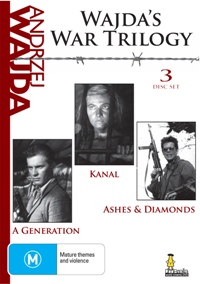

|
| BUY IT |
Wajda's War Trilogy represents a suite of films depicting the Polish resistance against the Nazi Germany army during World War II. Although the films are not sequential, they are linked by their common theme. These films started the Polish Film School movement of the 1950s and 1960s. The Region 4 release of this box set is identical to the Arrow Films Region 2 box set release.
The video and audio quality varies from very poor on Kanal, poor to average on A Generation to quite good for the final film, Ashes and Diamonds. The Region 1 US Criterion release of this box set, with its extensive extras, represents the best version of these films. The Region 4 release, at half the price of the Region 1 version, represents good value if you are willing to forego the extras.
| Video | |
| Audio | |
| Extras | |
| Plot | |
| Overall |
A Generation (1955) |
|
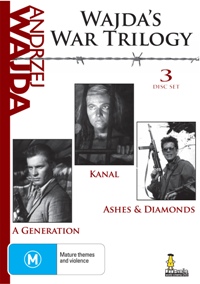

|
| BUY IT |
| General | Extras | ||
| Category | Drama |
Interviews-Crew-An Interview with Director Andrzej Wajda Trailer-Open City by Roberto Rosellini Trailer-Closely Observed Trains by Jiri Menzel Trailer-Europa Europa by Agnieszka Holland Trailer-The Thief by Pavel Chukhrai |
|
| Rating |

|
||
| Year Of Production | 1955 | ||
| Running Time | 83:11 | ||
| RSDL / Flipper | No/No | Cast & Crew | |
| Start Up | Ads Then Menu | ||
| Region Coding | 4 | Directed By | Andrzej Wajda |
|
Studio
Distributor |
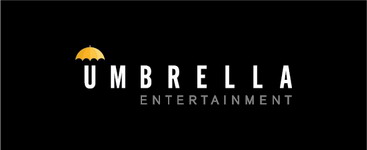 Umbrella Entertainment |
Starring |
Tadeusz Lomnicki Urszula Modrzynska Tadeusz Janczar Janusz Paluszkiewicz Ryszard Kotys Roman Polanski Ludwik Benoit Zofia Czerwinska Zbigniew Cybulski Tadeusz Fijewski Zygmunt Hobot Cezary Julski |
| Case | Amaray-Transparent-S/C-Dual | ||
| RPI | Box | Music | Andrzej Markowski |
| Video | Audio | ||
| Pan & Scan/Full Frame | Full Frame | Polish Dolby Digital 2.0 (192Kb/s) | |
| Widescreen Aspect Ratio | None | ||
| 16x9 Enhancement | No | ||
| Video Format | 576i (PAL) | ||
| Original Aspect Ratio | 1.33:1 | Miscellaneous | |
| Jacket Pictures | No | ||
| Subtitles | English | Smoking | Yes |
| Annoying Product Placement | No | ||
| Action In or After Credits | No | ||
A Generation is the first film of three films directed by Andrzej Wajda during the 1950s that focuses on the Polish reaction to Nazi occupation during World War II. The Australian distributor, Umbrella Entertainment has released these three films in a boxset entitled Wajda's War Trilogy, making these important films available for the first time for Region 4 collectors. These films mark the beginning of a movement in cinema called the Polish Film School which led to other Polish directors, cinematographers and actors getting wider recognition in the late 1950s and early 1960s. The actual film school opened in 1948 in Lodz, Poland and the film school was influenced by Italian Neorealism, a movement of cinema which emphasised real life events and the use of non-professional actors during the late 1940s and early 1950s (The Bicycle Thieves by Vittorio de Sica and Rome, Open City by Roberto Rossellini are the two most idealistic films of this era).
This film marked Wajda's film debut. In fact, the cast and crew were mainly all newcomers, all coming from the film school in Lodz, with only actors Tadeusz Lomnicki and Tadeusz Janczar having appeared in a film before. The film is a homage to the Italian Neorealist movement, with Wajda depicting the struggle for ordinary Polish youth and their resistance to Nazi occupation during World War Two. The events of the film take place in 1942, but of significance is the relief support for the Jewish ghetto which turned into the 1943 Warsaw Ghetto Uprising, the largest united Jewish resistance to Nazi oppression during the war. This resistance lasted three months before being crushed in April, 1943 and most cinema fans would know of it from its brutal depiction in Roman Polanski's 2002 film, The Pianist.
In fact, Roman Polanski made his film debut as an actor in this film, it is quite a revelation to see him in it and to contrast it to similar events depicted in his aforementioned Oscar-winning 2002 film. A Generation was made to celebrate 10 years of Communist government in 1955 so the conflict between sympathisers for the nationalist home army who supported the Polish government-in-exile in London and the communists (the youthful resistance depicted in the film) can be better understood as an analogy for the future direction of Poland after World War Two.
Zbigniew Cybulski, who plays Kostek in the film, appears only briefly at the beginning but would play an iconic role in the final film of the trilogy, Ashes and Diamonds.
The transfer of this film is very poor. The original source has visible damage, numerous white artefacts from dust on the film, scratches (possibly from dirt) and reel change markings.
The Aspect Ratio is 1:33:1 fullscreen.
The film is slightly soft throughout, however contrast between light and dark scenes is impressive considering that this was Director of Photography Jerzy Lipman's first film.
A Generation was shot in black and white (as were all the films in the Wajda's War Trilogy boxset) but the contrast mentioned previously really highlights the tones.
The film is presented on a single layer disc with a 41 minute interview as the main extra. This means that the film only occupies 2.6gb of space on the DVD and although it is only 83 minutes in length, it does explain why the average bitrate is only 4.3 Mb per second, which is fairly low. This accounts for the soft look of the film. There is significant scratches present in the transfer at the 60:00 mark and telecine wobble is evident in the beginning credit sequence and at the 76:00 minute mark also.
Subtitles are in white and do not stand out.
There is no RSDL change because the film is presented on a single layer disc.
| Sharpness | |
| Shadow Detail | |
| Colour | |
| Grain/Pixelization | |
| Film-To-Video Artefacts | |
| Film Artefacts | |
| Overall |
There is one audio track in Polish Dolby Digital 2.0 Mono encoded at 192 bps.
The dialogue is clear throughout, audio is synchronised but the audio does drop out at around the 53:00 minute mark intermittently for about a minute. The soundtrack also contains background hiss as a result of the unrestored film source used for this DVD transfer.
The soundtrack is subtle and supports the action on-screen, especially during the dramatic sequences involving the German soldiers and the Polish youth resistance.
There is no Surround Channel Usage as the movie is in mono, spread out over 2 front speakers.
There is also no usage of the Subwoofer.
| Dialogue | |
| Audio Sync | |
| Clicks/Pops/Dropouts | |
| Surround Channel Use | |
| Subwoofer | |
| Overall |
NOTE: To view non-R4 releases, your equipment needs to be multi-zone compatible and usually also NTSC compatible.
A Generation has been released in Region 2 (United Kingdom) and Region 1 (USA).
The Region 2 UK release is identical to the Region 4 release.
The Region 1 Criterion US release has a transfer that is soft but does not contain as many artefacts as the Region 2 and Region 4 release. It contains the following extras:
*Andrzej Wajda: On Becoming a Filmmaker, an exclusive interview with the director and film critic Jerzy Plazewski (33:38) 16x9 enhanced.
*Ceramics from Ilza (Ceramika Ilzecka), Wajda’s 1951 film school short (9:47)
*Behind-the-scenes production photos, publicity stills, posters, and original artwork by the director and an essay by film scholar Ewa Mazierska.
The Region 1 Criterion release has a better transfer and extras than the Region 2 and Region 4 releases.
If you can overlook the poor transfer, you can appreciate this homage to Italian Neorealism and the struggle of Polish resistance in World War Two. Region 4 cinema lovers can be thankful that Umbrella Entertainment have released this boxset of films, an important part of film history, highlighting the Polish Film School movement of the 1950s and 1960s leading to the development of great Polish directors such as Roman Polanski and Krzysztof Kieslowski. The Region 1 Criterion release has undergone a restoration (although not complete and comprehensive) and has different extras and is the reference DVD release. The Region 4 release is still a good release for Region 4 collectors and is much cheaper than the Region 1 release at the time of writing this review.
| Video | |
| Audio | |
| Extras | |
| Plot | |
| Overall |
| Review Equipment | |
| DVD | Sony BDP-S550, using HDMI output |
| Display | Samsung LA46A650 46 Inch LCD TV Series 6 FullHD 1080P 100Hz. Calibrated with THX Optimizer. This display device is 16x9 capable. |
| Audio Decoder | Sony STR-K1000P. Calibrated with THX Optimizer. |
| Amplification | Sony HTDDW1000 |
| Speakers | Sony 6.2 Surround (Left, Front, Right, Surround Left, Surround Back, Surround Right, 2 subwoofers) |
Kanal (1957) |
|
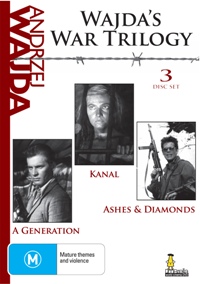

|
| BUY IT |
| General | Extras | ||
| Category | Drama |
Interviews-Crew-An Interview with Director Andrzej Wajda Trailer-Open City by Roberto Rosellini Trailer-Closely Observed Trains by Jiri Menzel Trailer-Europa Europa by Agnieszka Holland Trailer-The Tin Drum by Volker Schlöndorff. |
|
| Rating |

|
||
| Year Of Production | 1957 | ||
| Running Time | 91:50 | ||
| RSDL / Flipper | RSDL (84:53) | Cast & Crew | |
| Start Up | Ads Then Menu | ||
| Region Coding | 4 | Directed By | Andrzej Wajda |
|
Studio
Distributor |
 Umbrella Entertainment |
Starring |
Teresa Izewska Tadeusz Janczar Wienczyslaw Glinski Tadeusz Gwiazdowski Stanislaw Mikulski Emil Karewicz Vladek Sheybal Teresa Berezowska |
| Case | Amaray-Transparent-S/C-Dual | ||
| RPI | Box | Music | Adam Pawlikowski |
| Video | Audio | ||
| Pan & Scan/Full Frame | Full Frame | Polish Dolby Digital 2.0 mono (192Kb/s) | |
| Widescreen Aspect Ratio | None | ||
| 16x9 Enhancement | No | ||
| Video Format | 576i (PAL) | ||
| Original Aspect Ratio | 1.33:1 | Miscellaneous | |
| Jacket Pictures | No | ||
| Subtitles | English | Smoking | Yes |
| Annoying Product Placement | No | ||
| Action In or After Credits | No | ||
Kanal is the second film in Andrzej Wajda's trilogy of films depicting Polish resistance to German troops in Warsaw during World War II. Starting from 1939 when German troops first invaded Poland until the beginning of 1945 it is estimated that 85% of Warsaw was destroyed. Of 1,350,000 residents of Warsaw at the time, approximately 1,000,000 lost everything. As recently as 5 years ago, the current Polish Government estimated that the material loss suffered due to the German Army was somewhere in the vicinity of $US30 to $US50 billion. The Nazi Germany government, seeking recompense for lost land after World War 1 inflicted much suffering on Poland and its people, 6 million perished, half were Jews.
Andrzej Wajda was able to make this film at a time in Poland's history when the Government allowed greater personal freedoms for its citizens after the death of Joseph Stalin (otherwise it is doubtful that it could have been made). Kanal depicts the determination of Home Army resistance to the German Army. The Home Army began an uprising on August 1, 1944. Their goal was to resist the German Army in time for Soviet troops, who were coming across to fight the Germans, to assist. Alas, it seems that Stalin had a long memory and could not forget the embarrassing defeat of the Russian Red Army to Poland in 1921. The Russians conveniently marched into Warsaw in January, 1945 when it was much too late for the Polish resistance.
The Warsaw Uprising (as it came to be known) lasted 63 days but was finally crushed. The events of the film take place in mid-September 1944 when Lieutenant Zadra has 43 of his troops accounted for, starting from 70. After the introduction of the film, a narrator states that(SPOILER ALERT: highlight with mouse to read) by the end only 3 will survive. The film then shows how the main characters in the troop descend, under orders, into the city sewers to meet other resistance fighters in the middle of Warsaw. During the journey through the sewer system the members of the troop start to dwindle. Michal, the composer and supporter of the resistance, quotes Dante's Inferno when contrasting his situation in the sewers as a "descent into hell". Although we, as the audience, know the final outcome of the protagonists at the beginning of the film, Kanal employs a smart video and audio scheme to support it as a thriller. The video makes good use of shadow and the soundtrack imitates the sharp, syncopated rhythms of late 1940s, early 1950s film noir popular scores.
The overall damage to the print for this film is extensive. White artefacts are prevalent in every scene in the film. There are also issues with the audio, with drop-outs and clicks heard throughout.
The Aspect Ratio is 1:33:1 fullscreen.
The film does contain grain and low level noise, although shadow detail is excellent, especially during the second half of the film after the descent into the sewers.
Kanal was shot in black and white.
As soon as the film starts we witness scratches in the transfer and telecine wobble in the titles. White lines appear at 6:10. There are overwhelmingly excessive scratches after reel change markings at two points in the film, one from 18:40 until 21:00 and the other is from 56:55 to 57:41. White artefacts, which represents dust on the film, is prevalent in every scene. Notable film damage can be seen at 7:22, 7:55, 8:21, 11:13, 16:20, 18:34, 32:02, 37:08, 46:00, 55:01, 60:39, 67:41, 70:13, 76:04, 81:37, 83:43, 84:02, 88:34 and 91:35.
Subtitles are soft and support the black-and-white look of the film, being white in colour, they do not stand out.
The RSDL change occurs at 84:53 in the middle of a scene.
| Sharpness | |
| Shadow Detail | |
| Colour | |
| Grain/Pixelization | |
| Film-To-Video Artefacts | |
| Film Artefacts | |
| Overall |
The audio soundtrack to the film is also damaged.
The only audio option is a Polish Dolby Digital Mono soundtrack encoded for 192 kbps.
Dialogue is clear and easy to understand, however I have a feeling that this film was subjected to post-dub synchronisation as sometimes character dialogue does not match the images on screen. Audio drop-outs or clicks can be heard at 0:20, 7:55, 9:08, 9:18, 18:40, 37:18, 37:23, 38:00, 46:30, 59:08, 61:02, 75:43 and 90:54.
The music soundtrack heightens the drama of not knowing what is about to happen next. It has been done in the style of 1940s/1950s film noir thrillers.
There is no Surround Channel Usage as the soundtrack was recorded in Mono.
The Subwoofer is also not utilised.
| Dialogue | |
| Audio Sync | |
| Clicks/Pops/Dropouts | |
| Surround Channel Use | |
| Subwoofer | |
| Overall |
NOTE: To view non-R4 releases, your equipment needs to be multi-zone compatible and usually also NTSC compatible.
Kanal has been released in Region 2 (United Kingdom) and Region 1 (USA).
The Region 2 UK release is identical to the Region 4 release.
The Region 1 Criterion US release has a transfer that could still do with more restoration work but does not contain anywhere near as many artefacts as the Region 2 and Region 4 release. It contains the following extras:
*Andrzej Wajda: On Kanal, a 27-minute exclusive new interview with the director, assistant director Janusz Morgenstern, and film critic Jerzy Plazewski (27:28) 16x9 enhanced.
*Jan Nowak-Jezioranski: Courier from Warsaw, a new 28-minute interview by Wajda of a Warsaw Uprising insider (27:29)
*Behind-the-scenes production photos, publicity stills, posters and an essay by film critic John Simon.
There is also a Region 1 release of Kanal by the distributor Facets, but this version is VHS quality and is to be avoided.
Again, similarly to the first film in the War trilogy boxset, The Region 1 Criterion release has a better transfer and extras than the Region 2 and Region 4 releases.
Kanal had the honour of sharing the Special Jury Prize at the 1957 Cannes Festival with Ingmar Bergman's The Seventh Seal. Like The Seventh Seal, it is a great film, an important part of cinematic history. Both films share the similar theme of mortality and both share a timeless niche in world cinema because of it (unlike Friendly Persuasion by William Wyler which took out the Palme d'Or. Remember that film?) Kanal represents a movement away from Italian Neo-realism and towards the American cinema of film noir genre-themed films in it's style and look, albeit transposed to a war situation. Some film scholars contend that Kanal was the beginning of the Polish Film School movement.
Unfortunately, the transfer of this film leaves a lot to be desired. It really requires a thorough frame-by-frame restoration. The Region 1 Criterion version has a better quality transfer and with it's extras represents the best version of this film available currently on DVD.
| Video | |
| Audio | |
| Extras | |
| Plot | |
| Overall |
| Review Equipment | |
| DVD | Sony BDP-S550, using HDMI output |
| Display | Samsung LA46A650 46 Inch LCD TV Series 6 FullHD 1080P 100Hz. Calibrated with THX Optimizer. This display device is 16x9 capable. |
| Audio Decoder | Sony STR-K1000P. Calibrated with THX Optimizer. |
| Amplification | Sony HTDDW1000 |
| Speakers | Sony 6.2 Surround (Left, Front, Right, Surround Left, Surround Back, Surround Right, 2 subwoofers) |
Ashes & Diamonds (1958) |
|
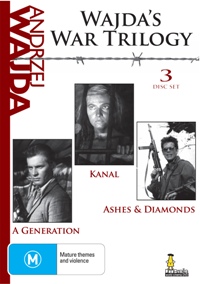

|
| BUY IT |
| General | Extras | ||
| Category | Drama |
Interviews-Crew-An Interview with Director Andrzej Wajda Trailer-Open City by Roberto Rosellini Trailer-Closely Observed Trains by Jiri Menzel Trailer-Europa Europa by Agnieszka Holland Trailer-The Tin Drum by Volker Schlöndorff |
|
| Rating |

|
||
| Year Of Production | 1958 | ||
| Running Time | 102:36 | ||
| RSDL / Flipper | Dual Layered | Cast & Crew | |
| Start Up | Ads Then Menu | ||
| Region Coding | 4 | Directed By | Andrzej Wajda |
|
Studio
Distributor |
 Umbrella Entertainment |
Starring |
Zbigniew Cybulski Ewa Krzyzewska Waclaw Zastrzezynski Adam Pawlikowski Bogumil Kobiela Jan Ciecierski Stanislaw Milski Artur Mlodnicki Halina Kwiatkowska |
| Case | Amaray-Transparent-S/C-Dual | ||
| RPI | Box | Music | Filip Nowak |
| Video | Audio | ||
| Pan & Scan/Full Frame | Unknown | Polish Dolby Digital 2.0 (192Kb/s) | |
| Widescreen Aspect Ratio | 1.66:1 | ||
| 16x9 Enhancement |
 |
||
| Video Format | 576i (PAL)/480i (NTSC) | ||
| Original Aspect Ratio | 1.66:1 | Miscellaneous | |
| Jacket Pictures | No | ||
| Subtitles | English | Smoking | Yes |
| Annoying Product Placement | No | ||
| Action In or After Credits | No | ||
Ashes and Diamonds is universally accepted, from a critical point of view, as the most mature film amongst the trilogy of films that make up the Wajda War Trilogy box set. This is true in terms of style but not necessarily plot. The plot requires the viewer to understand the historical context of the film to appreciate it. Polish viewers watching the film at the time of it's release would have understood better the conflict that is presented in the film, derived from the events that occurred in Poland at the end of world War II.
Maciek Chelmicki (Zbigniew Cybulski) is a young resistance fighter for the Polish Home Army, loyal to the Polish Government-in-exile in London, who, together with Andrzej (Adam Pawlikowski) has been designated to assassinate Szczuka (Waclaw Zastrzezynski), a Communist district leader, on the last day of World War II. At the beginning of the film they find out that they have killed the wrong person. They follow Szczuka to the Marpol Hotel where he is staying and in the meantime Maciek begins to fall for Krystyna (Ewa Krzyzewska), a young barmaid at the hotel. In getting to know Krystyna, Maciek yearns to leave his fighting behind and have a normal life, yet the conflict of duty, loyalty and orders is always weighing on him throughout the film.
Zbigniew Cybulski is outstanding in this film, he steals the limelight in every scene that he is in, so much so that the many sub-plots in the film get pushed into the background and can only be better appreciated after multiple viewings of the film. His performance can be best described as a mixture of James Dean, Warren Beatty and Jack Nicholson. It was a great tragedy, therefore, that Cybulski died young at 39, from injuries sustained whilst running to catch a train. Surprisingly, he did not work in many films in his career, rather settling on work in the theatre, but this performance in Ashes and Diamonds has made him an icon in his native Poland.
The film was shot during a period in Poland's history known as 'Polish October'. The government allowed liberal reforms for industry and culture. It was in this context that Maciek states in the film that he disliked the Soviets for not helping the resistance during the Warsaw Uprising in 1944. Such sentiment would definitely not have been allowed before 1956, and the plot itself, compromising of an assassination of a Communist leader was highly controversial for the time, especially amongst government circles, less so for the average Polish person who greatly sympathised with the Home Army resistance during World War II. However, to call Ashes and Diamonds an anti-communist film would be inaccurate. Rather it is a statement about the future direction of Poland in relation to it's generations, as is quoted from Polish 19th century poet Cyprian Norwid's poem in the film:
So often, are you as a blazing torch with flames
of burning rags falling about you flaming,
you know not if flames bring freedom or death.
Consuming all that you must cherish
if ashes only will be left, and want Chaos and tempest
Or will the ashes hold the glory of a starlike diamond
The Morning Star of everlasting triumph.
The analogy is made between the process of making diamonds from ashes via pressure acting upon coal and the fact that diamonds are valuable, hard and tough yet highly combustible when burnt. In this poem we understand that the final day of the War represents a possible liberation for Poland and yet it also represent possible future oppression. This then is is the conflict presented in the 1948 book by Jerzy Andrzejewski and in the 1958 film, whose screenplay was also adapted by the original book's author, Andrzejewski.
The film was smuggled to Venice for the 1959 Venice Film Festival where it awarded a special FIPRESCI prize for enterprising filmmaking. Martin Scorsese also showed it to Leonardo DiCaprio as preparation for his role in The Departed, as this is one of his favourite films and the two protagonists of both films are motivated by similar conflicts.
The transfer is the best amongst the three films in the Wajda War Trilogy box set.
The aspect ratio of the DVD is 1:66:1. It is 16x9 enhanced for widescreen televisions.
The film is presented on a single layer on the disc, taking up 3.8 gb of space with an average bitrate of 5.5 mb/s. As a result of this, with the film being 102 minutes long, there is low level noise evident during scenes with blacks in the background, but this is only subtle, it is not excessive.
Ashes and Diamonds was shot in Black and White, with excellent contrast highlighting day and night scenes.
Film artefacts are very minor in comparison to A Generation and Kanal. White Artefacts can be seen, all very briefly, at 12:58, 16:46, 17:58, 22:41, 29:52, 30:58, 42:37, 60:53 and at 90:00. There are white lines across the transfer at 28:09 and 28:30, these are also very brief. There are also two brief instances of digital tape dropout towards the end of the film.
Subtitles are removable and white.
There is no RSDL change as the film is presented on a single layer of this dual layered disc.
| Sharpness | |
| Shadow Detail | |
| Colour | |
| Grain/Pixelization | |
| Film-To-Video Artefacts | |
| Film Artefacts | |
| Overall |
In comparison to Kanal, the soundtrack to Ashes and Diamonds is exceptional!
There is one audio track in Polish Dolby Digital 2.0 Mono encoded at 192 bps.
I believe that dialogue has been post-synchronised, as in Kanal, but dialogue is clear throughout. There are no clicks or audio drop outs.
The music is similar in theme to Kanal, but more subtle and used only sparingly as this films contains a lot of dialogue scenes.
There is no Surround Channel Usage as the movie is in mono, spread out over 2 front speakers.
There is also no usage of the Subwoofer.
| Dialogue | |
| Audio Sync | |
| Clicks/Pops/Dropouts | |
| Surround Channel Use | |
| Subwoofer | |
| Overall |
NOTE: To view non-R4 releases, your equipment needs to be multi-zone compatible and usually also NTSC compatible.
Ashes and Diamonds has been released in Region 2 (United Kingdom and Czech Republic) and Region 1 (USA).
The Region 2 UK release is identical to the Region 4 release. The Region 2 Czech Republic release has no extras and is of inferior quality transfer-wise in comparison to the Region 2 UK release as the bit-rate is much lower and it is presented on a single layer DVD5 disc.
The Region 1 Criterion US release has a transfer that is less compressed than other Regional releases, it's average bitrate is 8.3 mb/s and it is the only release that utilises the complete capacity of a dual layered DVD as all the other Regional releases use only a single layer on their versions of the film. It contains the following extras:
* A commentary by film scholar Annette Insdorf, who comments on the film's historical context and content. Annette Insdorf has provided commentaries for fellow Polish director Krzysztof Kieślowski's films and also François Truffaut. Her commentaries, speaking from personal experience, are thorough, unique in tone and highly informative.
* Andrzej Wajda: On Ashes and Diamonds, a 36-minute exclusive new interview with the director, assistant director Janusz Morgenstern, and film critic Jerzy Plazewski (36:25) 16x9 enhanced.
* Vintage newsreel on the making of Ashes and Diamonds, a short newsreel, released to Polish cinemas in 1958, used as an original trailer for the film. (1:21)
* Behind-the-scenes production photos, publicity stills, posters and an essay by film critic Paul Coates.
There is also a Region 1 release of Ashes and Diamonds by the distributor Facets, but as was the case with the Facets release of Kanal this version is not as good as the Region 2 UK/Region 4 version or the release in Region 1 from Criterion.
Again, similarly to the first and the second films in the Wajda War Trilogy boxset, The Region 1 Criterion release has a better transfer and extras than the Region 2 and Region 4 releases.
Ashes and Diamonds is often referred to as Andrzej Wajda's masterpiece, and that may be, but it requires multiple viewings and an understanding of the historical context of the film to be properly appreciated. This film would appeal to cineastes rather than mainstream cinema viewers for that reason.
The video and audio transfer of the film is quite good, easily comparable to other DVD releases of mainstream films from the 1950s. Again, similarly to A Generation and Kanal, the Criterion Collection release of the Wajda War Trilogy films is the best version available, however the Region 4 release is quite acceptable if you don't need the extras.
| Video | |
| Audio | |
| Extras | |
| Plot | |
| Overall |
| Review Equipment | |
| DVD | Sony BDP-S550, using HDMI output |
| Display | Samsung LA46A650 46 Inch LCD TV Series 6 FullHD 1080P 100Hz. Calibrated with THX Optimizer. This display device is 16x9 capable. |
| Audio Decoder | Sony STR-K1000P. Calibrated with THX Optimizer. |
| Amplification | Sony HTDDW1000 |
| Speakers | Sony 6.2 Surround (Left, Front, Right, Surround Left, Surround Back, Surround Right, 2 subwoofers) |